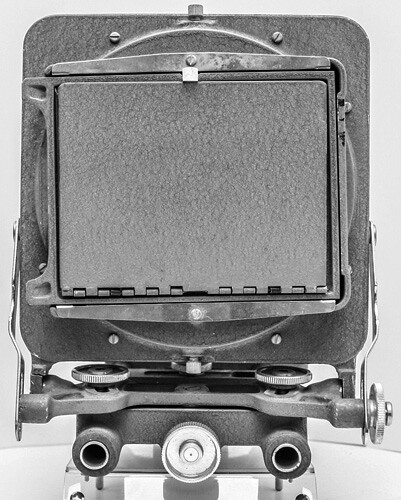Rotating back

|
| Newton New-Vue image by Noah Pardee (Image rights) |
A medium- or large-format camera with a rectangular (that is, not square) frame may have a rotable joint between the body and the film back (or the place where the film-back attaches). This allows the camera to be adjusted for horizontal or vertical pictures without turning the camera body. This is very desirable indeed if the camera uses a waist-level finder (which is very difficult to use with the camera turned). It also keeps the rest of the controls in their familiar and convenient arrangement. The back usually has indents so that it clicks into place vertically or horizontally, and then does not slip accidentally to some intermediate angle.
The most familiar example is perhaps the Mamiya RB67 (which is named for the feature). Although it contributes to the large bulk of the camera, it is a particularly good one, because the camera has masks in the reflex finder which automatically move to reflect the orientation of the film-back. This is not a new idea: Arthur Adams patented just such a mechanism to adjust a mask in the reflex focusing screen in 1909,[1] and provided it in the Minex reflex camera: rotating backs themselves must already have existed.
Some large-format cameras are made without a rotating back. In such cases, it is necessary to detach the film-holder (or plate-holder, or roll-film back) turn it and re-attach it. This arrangement is often confusingly called a reversing back.
Notes
- ↑ British Patent 27667 of 1909, Improvements in or relating to Photographic Cameras of the Type known as Reflecting or Reflex Cameras, filed November 1908 and granted November 1909 to Arthur Lewis Adams and Walter George Roberts; at Espacenet, the patent search facility of the European Patent Office.